Why is it so hard to find the best small block Chevy heads? The answer may seem blatantly obvious to some of you. But it is anything but. And the consequences emanating from the real answer are even more puzzling than those resulting from the obvious one.
The obvious answer is that, with so many manufacturers selling small block Chevy heads, finding the one that meets one’s requirements can be challenging. The belief isn’t wrong. But it fails to tell the whole story as the issue here isn’t merely that of supply and demand.
Most of the time sellers offering small block Chevy heads don’t offer their units in your budget. Or the range of their products is minimal. Or the reputation of the seller itself isn’t good enough to merit buying their products. The buyer is thus left with no choice but to conduct their own research.
Aluminum vs. Iron
Although aluminum heads have become uber-popular of late, enthusiasts still compare them with the iron heads on multiple counts. That’s the reason why we have decided to compare both of them briefly in this section. Read on to know how they fared:
- Durability: Ported iron heads last longer than their aluminum counterparts simply because they can withstand more heat. They’d, at worse, warp at temperatures at which an aluminum head would completely melt.
- Cost: Aluminum heads cost more than their iron counterparts. That’s because while iron heads can create more power without much modification, aluminum heads need you to increase their compression ratio to achieve to get a greater power output.
- Power: Which of the two engines will create more power depends on your engine’s compression ratio. If the compression ratio is low and you want more power, stick with ported iron engines. Otherwise, aluminum heads are your best bet.
- Reparability: As long as the damage is very bad, aluminum heads will be much easier to repair. That can also be because of the fact that these heads are more susceptible to damage than their iron counterparts.
- Weight: Here is one factor on which iron heads lag behind. You can expect a pair of aftermarket iron heads to weigh at least 45 to 50 pounds more over the front axle than that of aluminum heads.
Best Small Block Chevy Heads
Edelbrock 7501 Performer RPM Air-Gap Intake Manifold
Best small block Chevy performance heads
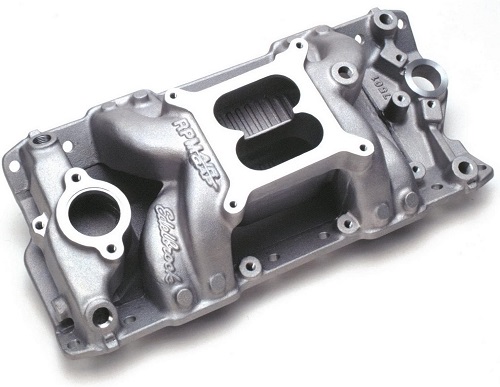
Its dual-intake design allows this small block Chevy head to provide multiple benefits. This model performs better than single-plane manifolds when it comes to making power at cruising RPM and off idle. Its smaller plenum also increases the velocity of the airflow to the engine.
The narrowness inside the plenums also allows them to transmit induction pulses between the carburetor and intake valve better. This, in turn, increases the engine’s fuel atomization and metering, especially when you’re revving it at low RPM.
Yet another notable element in this model’s design is the open space between the hot engine oil and the intake runners. This space ensures excellent dissipation of heat, thereby ensuring more power and a cooler, denser charge.
On top of everything else, this manifold features two distributor clamp locations, nitrous bosses, and rear water outlets. It also has a temperature sending unit boss that demolishes all water necks. All in all, this unit has everything that separate the best small block Chevy heads from the ordinary ones.
Pros
- Increases fuel atomization
- Ensures excellent heat dissipation
- Provides a denser, cooler charge
Cons
- Won’t fit under stock corvette hood
DNA Motoring CYLH-SBC-350 Aluminum Bare Cylinder Head
Best small block Chevy cylinder heads
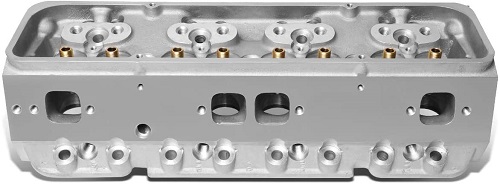
Multiple features of this small block Chevy head make it a reliable option. Start with its material of construction. The higher-grade aluminum used in its making allows this head to weigh lighter than iron heads. It also equips it with the ability to boost greater air flow. Here’s how.
Inside the external casing are advanced ports that straighten the airflow by not putting any restrictions in its way. Similar is the case with the spark plug whose straight angle makes full use of the enhanced airflow to provide a cleaner spark in no time.
Enthusiasts among you might find it pleasing to note that this model has a 68cc combustion chamber. That’s because these chambers are famous in the market for retaining stock compression and improving performance on 1970 engines and earlier.
That isn’t to say that this unit won’t work well with the engines that came after 1970. DNA assures us that it is a perfect fit for all small block Chevy engines up to 1986. You can also use them with various SBC engines such as 302, 350, 327, 383, and 400.
This is truly one of the best aluminum heads for small block Chevy engine.
Pros
- Lighter than iron heads
- Provides greater airflow
- Tight clearance for the pushrods
Cons
- Might have to ground sharp ends of exposed threads with a dremel
Edelbrock 2701 Performer Intake Manifold
Best SBC heads for torque
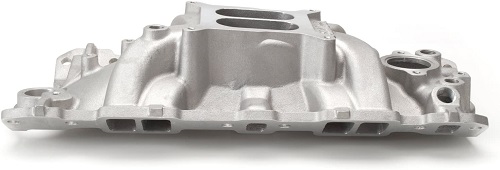
There is a very technical explanation as to why dual-plane manifolds like Edelbrock 2701 offer better street performance. Let’s try and understand it in simple words. Such units have smaller plenums than single-plane manifolds that allows them to boost better airflow velocity.
This property allows dual-plane manifolds to transmit induction pulses between the carburetor and the intake valve better. It also gives them the ability to make better power at cruising RPM and off idle. And since street driving mostly involves cruising, that’s why this manifold does so well in the same.
Yet another notable feature of this model is the better acceleration that it provides from a stop. You might have seen a few vehicles whose ‘pick’ is greater than those costing twice as much. Well, it’s manifolds like the Edelbrock 2701 and not anything else that is responsible.
All of this isn’t to say that this small block Chevy head isn’t without any shortcomings. We aren’t impressed by its above-average price. Our experts also think that its RPM range (between idle and 5,500) is at least 500RPM short of what is offered by other dual-plane manifolds.
Pros
- Excellent street performance
- Produces great low-end torque
- Better acceleration from stop
Cons
- Relatively small RPM range
Professional Products 52021 Satin Typhoon Intake Manifold
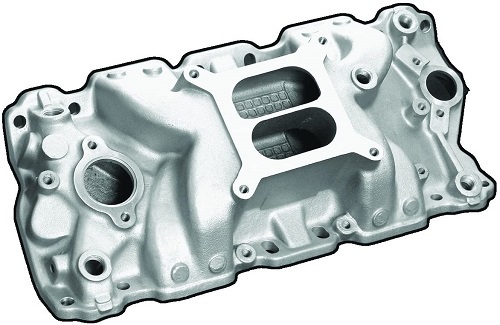
The vast majority of small block Chevy heads that you see on the market cost a fortune. Some who cost less manage to do so by cutting invisible corners. The Professional Products 52021 Satin Typhoon Intake Manifold belongs to neither of the two categories. Here’s why.
Its manufacturer has provided this dual-plane manifold with a split opening beneath its carburetor mounting pad. Each side of the opening is more restrictive to air flow, thereby boasting a wider power range and working better at low RPM.
The division of its manifold into two plenum section allows this Chevy head to harness other benefits as well. Its 180-degree design helps it do a better job of balancing air between cylinders. This, in turn, empowers this model to remain more balanced throughout its RPM range.
On top of everything else, this model’s competitive asking price allows it to come across as a budget-option, especially for dual-plane manifolds. And it is available in your budget without cutting any corners – as the presence of 4-corner water ports and dual distributor hold-downs in its design show.
Pros
- Competitively priced
- Works better at low RPM
- Puts in a balanced performance
Cons
- Heavy
Edelbrock 2116 Performer Vortec Aluminum Intake Manifold
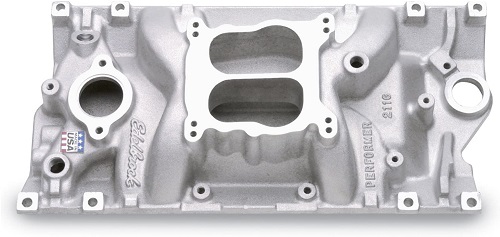
How many small block Chevy heads are capable of accepting both spread-bore and square-bore carburetors? What percentage of the units available on the market do you think accepts late model water neck, air conditioning and alternator? Its ability to do both means Edelbrock 2116 is in a minority.
That’s an extremely valuable feature of this model as long as you have no problems with its slightly inflated asking price. One which has turned this Aluminum intake manifold into the second most expensive small block Chevy head on the market. But it has the features to justify its asking price.
It breaks ranks with other dual-plane manifolds by including provisions for external water bypass. The RPM range of this model – which ranges between 0 and 5,500 – does more than enough to ensure seamless performance on the street and, occasionally, on the racing track.
To further sweeten the deal, this model comes with a moneyback guarantee. Edelbrock gives you the option to return it without having to answer any questions within 30 days of purchase. That means that you’ll have literally nothing to lose if you end up choosing this product.
Pros
- Provision for external water bypass
- Accepts both spread- and square-bore carburetors
- Improves engine torque
Cons
- Slightly expensive
Professional Products 52006 Polished Cyclone Intake Manifold
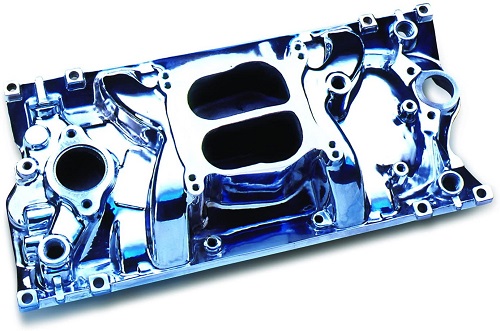
Most small block Chevy heads aren’t easy to install. They require you to perform difficult modifications with tools that can’t be found in your local hardware store. You are therefore left with no choice but to pay big bucks to a mechanic. The Professional Products 52006 is different.
This unit justifies its otherwise lofty asking price by making its installation super easy. Professional Products has included all those tools in its package that you’d need to get it up and running. Anyone with prior knowledge of these things can use those tools to install this model in a few hours’ time.
Its high-end design is equally worthy of our praise. The 52006 features dual distributor hold-downs, four corner water outlets and includes a square bore carburetor adaptor. Apart from coming handy on other counts, all these design elements help this model work well with late HEI and AC brackets.
What’s more, you can even fit this model into 1996 and later Vortec engines, though some modifications will be required. But the fact that the modifications won’t be related to the manifold itself means expert car mechanics can easily carry them.
Pros
- 4-corner water outlets
- Can be used on V8 engine
- Fits both Vortec cast iron and E-Tec aluminum heads
Cons
- None
What to consider when buying best SBC Heads
Type of head
Small block Chevy heads are available in the following types:
Vortec Head
Sporting centrebolt valve covers and a strange sawtooth, the Vortec head first hit the market in 1996. It was equipped with 170-cc intake port volume, 1.94/1.50-inch valve sizes and a 64-cc chamber. Its excellent performance soon made it into one of the most popular Chevy heads ever produced.
Aside from its brilliant performance, another feature that set this head apart from those that came before it was its meager price. You could easily get a pair of these heads for around $300 – a pittance once you consider that previous heads cost almost twice that amount.
That isn’t to say that this head doesn’t have its shortcomings. It is only for those budget-minded users whose power goals are extremely low. As this model seldom crosses the 400hp mark with a 355-cc small-block. That is to say that it isn’t made for power-hungry vehicles.
Pros
- Competitively priced
- Excellent value for money
- Good performance
Cons
- Usually provides power less than 400hp.
OE Head
These heads were popular before the arrival of their Vortec counterparts in the late 90s. They had lightweight rocker arms, higher rpm operation and had wedge combustion chambers that allowed for a broader power band. Enthusiasts further divided these heads into two types.
These types included open chamber and close chamber heads. The latter were the preferred choice of the majority as they produced more power and had swirl inside the combustion chamber. However, close chamber heads had poor burn characteristics and literally devoured fuel.
Both these heads had dirtier castings than the Vortec heads that preceded them. That’s because the factory back then paid little attention to how much metal it was using in each casting. This extra metal wasn’t without its benefits though as it made the older heads less prone to overheating.
Pros
- Less prone to overheating
- Produced more power
Cons
- Extremely dirty
- Pricey
Single-Plane Manifold Vs Dual-Plane Manifold
Here’s how you can choose between the two intake manifolds:
Dual-Plane Manifold
These manifolds have traditionally been the design choice for most OEM stock intakes. They feature two separate intakes that are divided by a plenum of unequal height. Each of the two ‘planes’ take air from their area and supplies it to the half of the engine’s cylinders that is exposed to them.
The cylinders receiving air from both planes have different intake cycles thanks to 180-degree of crankshaft rotation. This difference, alongside the slightly different volumes of air that both the planes will provide to the cylinder, empowers dual-plane manifolds to produce great low-end torque.
Aside from that, since the reduction in size of each plenum puts more pressure on the air passing through it, dual-plane manifolds also achieve greater airflow velocity. They even improve the engine’s metering and fuel atomization because of their ability to transmit induction pulses.
Pros
| Cons
|
Single-Plane Manifold
The main idea behind single-plane manifolds is to provide as much air to the engine as possible with as little airflow restriction as possible. They have one plenum supplying air to all the engine’s cylinders, which has minimum bends to minimize airflow restriction and help a small carburetor act larger.
This arrangement is great for race car engines or those vehicles whose drivers like to test them close to speed limits. It isn’t that good at lower RPMs. That’s because when the RPMs are low, the air velocity will also be lower and the carburetor will receive less signals.
And that would result in an air/fuel density that would be lower vis-à-vis dual-plane intakes. All of these factors would then combine to reduce torque at low speeds. That’s the main reason why single-plane manifolds aren’t recommended by experts for street driving.
Pros
| Cons
|
Identifiers
There are at least three identifies that you need to recognize to correctly identify the type of cylinder head you’re currently using. They include Casting Number, Casting Date and Cast Shape. Here’s how you can pinpoint the exact location of all of them.
Casting Numbers
Casting Numbers are used to identify the subassembly or whole assembly of Chevrolet products. They are engraved on the cylinder during the manufacturing process and their location depends on whether you’re using Gen 1 and Gen II heads or newer cylinder heads. Let us explain this point.
Gen 1 and Gen II heads have their casting numbers located under the valve cover between the valve spring seats. Newer cylinder heads, meanwhile, have these numbers in their valve galley. Identify which of the two heads you’re currently using to correctly pinpoint the casting numbers’ exact location.
Casting Date
Similar to the Casting Numbers, the Casting Date is also cast onto the head during the manufacturing process in the foundry. You may have to remove the valve cover to make them visible. Their position is between the valve seats on the Gen 1 factory cylinder.
As you’re reading the casting date, you may notice that two or three numbers are following a letter. The letter range, which stretches between ‘A’ and ‘M’, represents months of the year. The digit after the letter represents the day whereas the one after that represents year.
Cast Shapes
Usually found on the ends of cylinder heads, the cast shapes don’t tell you anything about the specifics of the cylinder head on which they might be imprinted. Their only purpose of being is to differentiate a performance head from a non-performance head.
Cross-referencing the casting dates and casting numbers is the best way to properly classify cylinder heads. That will make it easier for you to identify whether you have a ‘Fuelie’ cylinder head, ‘Camel Hump’ cylinder head or any other.
How to install Heads on A Chevy
Conclusion
All the best small block Chevy heads that you saw above are different from each other. Some have lower RPM ranges, others perform better at high speeds. Some are available in most people’s budgets whereas the remaining ones cost a fortune. Yet there’s one thing that units them.
These models are the best money can buy. They come not only with stellar reputations but also with huge warranties and trust of thousands of drivers like you. You can therefore count on them to do what they promise and not rip you off.
I thought arcticle was supposed to be about Small Block Early Chevy (SBC) heads, but most of the article appears to be SBC intake manifolds.